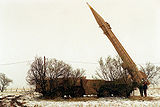- Rodong-1
-
Rodong-1 Chosŏn'gŭl 로동1 (northern spelling)
노동1 (southern spelling)Hancha 蘆洞1 McCune–Reischauer Rodong-1 / Nodong-1 Revised Romanization Rodong-1 / Nodong-1 The Rodong-1 (spelled Nodong-1 in South Korea) is a single stage, mobile liquid propellant medium range ballistic missile developed by North Korea. Developed in the mid-1980s, it is an adaptation of the Soviet SS-1, more commonly known by its NATO reporting name "Scud".
Contents
Overview
It is believed North Korea obtained Scud-B designs from Egypt and possibly Scud-C designs from China, and reverse-engineered them into a larger, longer-distance weapon dubbed the Rodong. U.S. reconnaissance satellites first detected this type in May 1990. North Korea alarmed Japan in 1993 by launching a test missile towards Honshū, although the missile fell harmlessly into the Sea of Japan.
The precise capabilities and specifications of the missile are unknown; even the fact of its production and deployment are controversial. It is accepted to be a larger variant of the Scud-C, with a reported mass of 15,000-16,000 kg, with a diameter of about 1.3 m and a length of 15–17 m. Its range is estimated between 1,000 and 1,300 km and its maximum payload between 700 and 750 kg. Its poor accuracy makes it ineffectual against hardened military targets, however, so its speculated use would be to deliver a chemical, biological or nuclear warhead against large installations or cities.
Variants called the Rodong-2, Rodong-B, and Rodong-X were developed, but production was halted in 1996 or 1997 due to North Korea's severe economic hardships, and to focus resources on the more advanced Taepodong-1 Taepodong-X design. The Rodong-1 remained a lucrative export, however. Libya and Syria are believed to possess Rodong-1s, and variants are believed to be the basis for Iran's Shahab-3 and Pakistan's Ghauri missiles.
North Korea fired 7 of these missiles from their east coast on July 4, 2009.[1]
Operators
See also
- North Korean missile tests
- Musudan-1
- North Korean defense industry
- Military of North Korea
References
- ^ In N. Korea, Missiles Herald A Defiant 4th. Washington Post. July 5, 2009
External links
- CNS report North Korea's Ballistic Missile Capabilities 2006
- Center for Nonproliferation Studies, North Korea's Ballistic Missile Program
- Claremont Institute, MissileThreat.com, No-dong 1
- GlobalSecurity.org, Nodong-1
- National Threat Initiative, Nodong: Overview and Technical Assessment
- Institute for Science and International Security, ISIS
Soviet Union R-11 Zemlya · R-17 Elbrus
Iran Iraq Al HusseinNorth Korea Hwasong-5 · Hwasong-6 · Paektusan · Rodong-1Short-range - KN-2
- Hwasong-5
- Hwasong-6
Medium-range - Rodong-1
- Rodong-2
- Taepodong-1
- BM25 Musudan
ICBM Space launch vehicles - Paektusan
- Unha
Categories:- Scud missiles
- Ballistic missiles of North Korea
- Medium-range ballistic missiles
Wikimedia Foundation. 2010.
